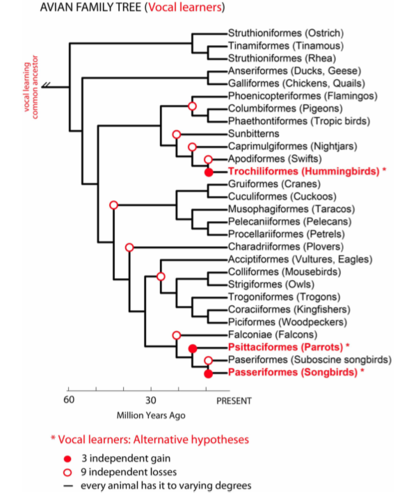Hummingbird Vocal Learning
Biology 342 Fall 2015
Alex Loukides and Hannah McConnell
Phylogeny
Populations of hummingbirds in different geological locations have slightly different songs. There are genetic correlations to these differences between the different populations of these hummingbirds. While no hummingbird species have been shown not to be vocal learners, not all species display the same complexity and variety in the songs they learn. The white-throated hummingbird, Leucochloris albicollis, sings with simple syllables and syntax; the sombre hummingbird, Aphantochroa cirrochloris, sings simple syntax but complex syllables; and the rufous-breasted hermit, Glaucis hirsuta, sings with complex syllables and syntax. Not enough data has been collected to determine whether these differences apply to genera or only species. There are three primary hypotheses as to the evolutionary history of vocal learning in class Aves.
-
Three independent origins of vocal learning in Trochiliformes, Psittaciformes, and Passeriformes
-
Two independent origins of vocal learning: Once in Trochiliformes and once in the common ancestor of Passeriformes and Psittaciformes. One independent loss of vocal learning within Passeriformes in the suboscine songbirds.
-
Single origin of vocal learning in a common ancestor to all avian vocal learners. Nine independent losses of vocal learning in related orders.
Morphology:
Two other theories deal with the morphology of the brain. The rudimentary structures theory proposes that the nuclei found in vocal learners are actually present, in primitive or undeveloped form, in all avians (and potentially in all vertebrates, given the observed convergence between avian and mammalian vocal nuclei). Under this theory, vocal nuclei are not unique to vocal learners, only enlarged or specialized.
The motor theory proposes that the cerebral systems of vocal learning evolved as a specialization of a pre-existing neurological circuit in charge of learned motor sequencing. Like the rudimentary structures theory, the motor theory proposes that all species have the capacity for vocal learning to some degree, and this ability is only pronounced in those species designated “vocal learners”.

Figure 1: Phylogenic tree of avian species that have vocalizations. The three species in red are those that have vocal learning. (Christopher Petkov and Erich Jarvis - Petkov, CI; Jarvis ED (2012). "Birds, primates, and spoken language origins: behavioral phenotypes and neurobiological substrates". Front. Evol. Neurosci. 4:12.)